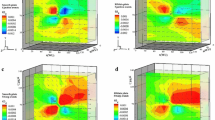Abstract
The present study employed the image-based bubble image velocimetry (BIV) technique to investigate the flow kinematics of a plunging breaking wave impinging on a geometry-simplified, unrestrained tension leg platform (TLP). A high-speed camera was used to record images for the BIV velocity determination for both fluid and structure velocities. The plunging breaker was generated using a wave focusing method, and repeated measurements were acquired to calculate the mean flow and turbulence intensity using ensemble averaging. BIV measurements were performed on two perpendicular planes: side view and top view. The flow measurements were compared with those of a similar experiment on a fixed structure by Ryu et al. (Exp Fluids 43(4):555–567, 2007a). The maximum velocity occurred in the run-up stage with a magnitude reaching 2.8C with C being the phase speed of the breaking wave. The dominant velocities for three distinct phases—impingement, run-up, and overtopping—are very close to those found on the fixed structure. Turbulence intensity was also examined, and the ratio among the three components was quantified. Ryu et al. (Appl Ocean Res 29(3):128–136, 2007b) reported that Ritter’s dam-break flow solution agrees surprisingly well with the measured green water velocity on the fixed structure to a certain degree. The present study followed the same approach and confirmed that Ritter’s solution is also in excellent agreement with the green water velocity on the unrestrained TLP model. Based on the self-similar behavior, the prediction equation proposed by Ryu et al. (2007a) was used to model the green water velocity distribution. The results show that the prediction equation is applicable to not only a fixed structure, but also the unrestrained TLP for green water velocity caused by extreme waves.















Similar content being viewed by others
References
Ariyarathne K, Chang K-A, Mercier R (2012) Green water impact pressure on a three-dimensional model structure. Exp Fluids 53(6):1879–1894
Buchner B (1995) The impact of green water on FPSO design. Offshore Technology Conference, OTC 7698, Houston, Texas, pp 47–57
Chang K-A, Ariyarathne K, Mercier R (2011) Three-dimensional green water velocity on a model structure. Exp Fluids 51(2):327–345
Christensen ED (2006) Large eddy simulation of spilling and plunging breakers. Coast Eng 53(5–6):463–485
Davis MC, Zarnick EE (1964) Testing ship models in transient waves. In: Symposium on naval hydrodynamics. Bergen, Norway, pp 507
Hamoudi B, Varyani KS (1998) Significant load and green water on deck of offshore units/vessels. Ocean Eng 25(8):715–731
Lin P, Liu PL-F (1998) A numerical study of breaking waves in the surf zone. J Fluid Mech 359:239–264
Lin C, Hsieh S-C, Kuo K-J, Chang K-A (2008) Periodic oscillation caused by a flow over a vertical drop pool. J Hydraul Eng ASCE 134(7):948–960
Lin C, Hsieh S-C, Lin I-J, Chang K-A, Raikar RV (2012) Flow property and self-similarity in steady hydraulic jumps. Exp Fluids 53(5):1591–1616
Mori N, Chang K-A (2003) Introduction to MPIV. Online PIV software, from http://www.oceanwave.jp/softwares/mpiv
Nielsen KB, Mayer S (2004) Numerical prediction of green water incidents. Ocean Eng 31(3–4):363–399
Pedrozo-Acuna A, de Alegria-Arzaburu AR, Torres-Freyermuth A, Mendoza E, Silva R (2011) Laboratory investigation of pressure gradients induced by plunging breakers. Coast Eng 58(8):722–738
Perlin M, He JH, Bernal LP (1996) An experimental study of deep water plunging breakers. Phys Fluids 8(9):2365–2374
Ritter A (1892) Fortpflanzung der Wasserwellen. Vereine Deutscher Ingenieure Zeitswchrift 36(33):947–954
Rivillas-Ospina G, Pedrozo-Acuna A, Silva R, Torres-Freyermuth A, Gutierrez C (2012) Estimation of the velocity field induced by plunging breakers in the surf and swash zones. Exp Fluids 52(1):53–68
Ryu Y, Chang K-A (2008) Green water void fraction due to breaking wave impinging and overtopping. Exp Fluids 45(5):883–898
Ryu Y, Chang K-A, Lim HJ (2005) Use of bubble image velocimetry for measurement of plunging wave impinging on structure and associated green water. Meas Sci Technol 16(10):1945–1953
Ryu YG, Chang K-A, Mercier R (2007a) Runup and green water velocities due to breaking wave impinging and overtopping. Exp Fluids 43(4):555–567
Ryu Y, Chang K-A, Mercier R (2007b) Application of dam-break flow to green water prediction. Appl Ocean Res 29(3):128–136
Schonberg T, Rainey RCT (2002) A hydrodynamic model of green water incidents. Appl Ocean Res 24(5):299–307
Song YK, Chang K-A, Ryu Y, Kwon SH (2013) Experimental study on flow kinematics and impact pressure in liquid sloshing. Exp Fluids 54(9):1–20
Song YK, Chang K-A, Ariyarathne K, Mercier R (2015) Surface velocity and impact pressure of green water flow on a fixed model structure in a large wave basin. Ocean Eng 104:40–51
Svendsen IA (1987) Analysis of surf zone turbulence. J Geophys Res Oceans 92(C5):5115–5124
Wang DW, Mitchell DA, Teague WJ, Jarosz E, Hulbert MS (2005) Extreme waves under Hurricane Ivan. Science 309(5736):896
Acknowledgments
The authors wish to thank the financial support provided by the Offshore Technology Research Center through its Industry Consortium, under the project entitled “Implementation of bubble image velocimetry in OTRC wave basin.”
Conflict of interest
The authors declare that they have no conflict of interest.
Author information
Authors and Affiliations
Corresponding author
Appendix: Comparisons of mean and instantaneous velocity fields
Appendix: Comparisons of mean and instantaneous velocity fields
Rights and permissions
About this article
Cite this article
Chuang, WL., Chang, KA. & Mercier, R. Green water velocity due to breaking wave impingement on a tension leg platform. Exp Fluids 56, 139 (2015). https://doi.org/10.1007/s00348-015-2010-y
Received:
Revised:
Accepted:
Published:
DOI: https://doi.org/10.1007/s00348-015-2010-y






